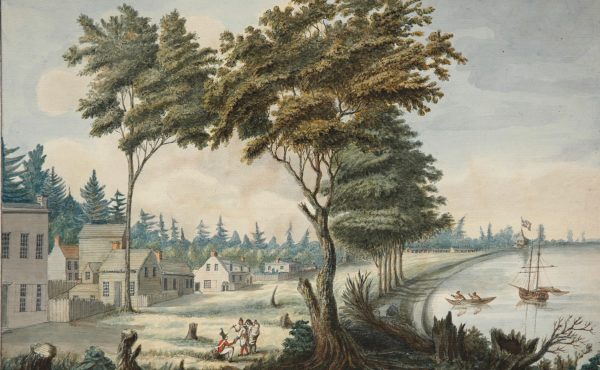

He walked west along Queen Street, away from the centre of town. On the northwest corner of University and Queen sat a little building called Campbell House. It occupied a postage stamp of grass and looked out on nothing that had been there when its lawns had been laid. At some point in the past, some cherishing landowner, now dead, had fought off the parcelling of his little estate to an interest of some kind. Maybe a tiny hermit’s cabin on his grounds had been put forth as hallowed, a place the loss of which would spell an end of something important. That battle was lost, of course, as so many battles to save buildings had been lost in this city, and it was worse in all directions from that place where a little blot of history in the form of a house still remained. Buildings raised in the fifties thundered up in places where there were once familiar landmarks: toll booths, favourite old shops, cooperages with big working grounds under which lay the bodies of horses loved and worked to death.
In this passage, John, one of the main characters in the book’s modern story, is inspired by the sight of a very old Toronto house preserved amidst more modern buildings to think bitterly about the loss of history and sense of place in a young and constantly transforming city like Toronto. It is one of the major themes of the book.
The reference to Campbell House, however, makes this passage is a lot more complicated than the simple nostalgic rant that it looks like at first sight.
In John’s mind, the house and its lot seems to be a sign of rare historical stability and resistance, a grounded sense of place that contrasts with the constant change around it. Indeed, Campbell House is one of the oldest buildings in Toronto, built in 1822.
But the irony is that the house was built in a different part of town, and was moved in one piece to its present location in 1972, in a highly public and dramatic operation, in order to preserve it. The history of solid landownership John imagines for this house and plot of land is exactly that, imaginary.
The passage suggests that John is an unreliable narrator, not fully knowledgeable about the Toronto history that he seeks to protect, and that we should take his opinions with a grain of salt. In one way, the real history of Campbell House suggests that the situation is even worse than he imagines. Even this seeming example of stability amidst change is, in fact, out of place, detached from the original location and context where it acted and created memories in the city’s history. The difficulty of keeping a sense of place in Toronto is thus even worse than he imagines. At the same time, the real story undermines his rant about Toronto’s neglect of its history, because Campbell House was an early example of many different people in Toronto consciously coming together to save a historic building, rather than an eccentric individual effort as he imagines, and it helped set in motion a movement to save historical buildings in Toronto that had been active and sometimes successful for a quarter century before 1997, the year in which John is thinking these thoughts.
The additional irony is that Campbell House was originally located at the intersection of Adelaide St. and Frederick St. — the heart of old Toronto where most of the action of the novel’s parallel nineteenth-century story takes place, in fact, less than 5 blocks from the apothecary J. Hallam’s shop at 81 King St. E. And, in a further irony, it is the oldest surviving building from this original part of the city — but in order to survive it was relocated outside the original bounds of the old city. (One question I have not been able to find the answer to is what this plot of land at Queen and University was before the house was moved to it. It seems surprising that a plot of land was available at this valuable location, and in this sense perhaps John’s imagination of some eccentric twist of fate for the lot is true — any information is welcome).
The fortunes of the house followed the declining fortunes of this oldest part of the city — a wealthy residence for much of the 19th century, then a business place, then a factory, eventually falling into disrepair. The final owners planned to demolish it to extend a parking lot, but in response to an emerging historical consciousness in the city, offered the house itself for free to anyone who could move it. As Wikipedia tells the story, saving the house became something of a collective endeavour for the city:
A professional association of Trial Lawyers, known as the Advocates Society, launched a campaign to save the building. Eventually it was arranged that the building would be moved to its current location at the corner of University Avenue and Queen Street West, south of the Canada Life Building. With assistance from Toronto Transit Commission maintenance trucks, the 300-ton home was moved 5305 feet northwest from Adelaide Street to the current location in 1972. The move was a major spectacle, and attracted a large crowd as several downtown streets needed to be shut down.
There are a series of pictures of the move available on Campbell House’s website. Wikipedia also suggests that “The preservation of the house was an important turning point in architectural preservation in Toronto.”
A final coda in the Campbell House story — when Canada Life proposed developing the patch of grass to the west of Campbell House at Queen West and Simcoe with a tall building (now the Federal Court building), former Mayor John Sewell, in his Eye Weekly column, attacked the proposal as being out of proportion for Queen Street West. He suggested, instead, that Campbell House be moved once again, one block west to the empty lot, since its size and appearance was more in keeping with Queen West, and that the new Canada Life development be built instead in its place on the corner at University, the huge avenue being a more suitable location for a building of the proposed size. The idea was not pursued. (I do not have a link to this article as Eye Magazine has recently redesigned its website and lost its archives, so I am relying on memory). Instead, in exchange for its out-of-proportion building, Canada Life paid for the Queen West Heritage study, which led to the creation of the Queen West Heritage District that will protect heritage buildings from demolition (though, tragically, not fire) along the route where John continued his walk along Queen West that day, ruminating on Toronto’s loss of history.
Photograph by SimonP




4 comments
Is history useful in a city of newcomers? If so, how so?
Sadly, Campbell House’s website has not been updated in a while. I clicked on the Special Events page and it has the 2007 calendar. The activities look like fun, I’m sure it’s great for families.
And what’s even more ironic, even though there was support for the proposal to move the House west to beside the Rex – so that Canada Life could build their monster on University Ave – many said the House shouldn’t be moved again. Now irony of ironies, the Canada Life folks (now Great West Life) have opposed the finalisation of the Heritage Study, and want to move the House right to the curb so they could build behind it. Actually, I understand that it is lawyers (Advocates Society) who want this move. Others have suggested moving the House across the street beside Osgoode Hall to face University Avenue on the east.
Not surprising sicne they have renegged on so many commitments to this neighbourhood, including opening up the green space beside the old building on University Avenue.
from 1929:

from 1931:
